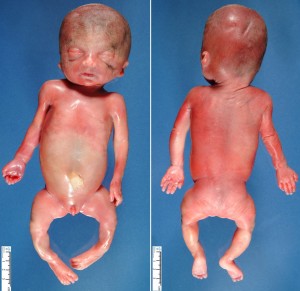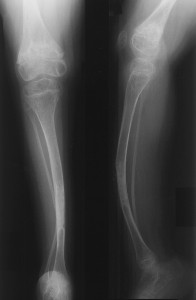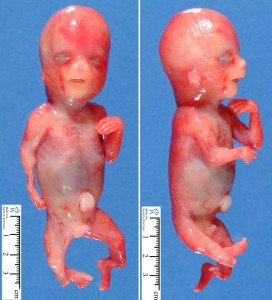Osteogenesis Imperfecta is a rare hereditary condition that is a serious cause of concern for sufferers as well as their family members. Read on to know all about the causes, symptoms, diagnosis and treatment of Osteogenesis Imperfecta.
Osteogenesis Imperfecta Definition
Page Contents
- 1 Osteogenesis Imperfecta Definition
- 2 Osteogenesis Imperfecta In Children
- 3 Osteogenesis Imperfecta Types
- 4 Osteogenesis Imperfecta Causes
- 5 Osteogenesis Imperfecta Symptoms
- 6 Osteogenesis Imperfecta and Eyes
- 7 Osteogenesis Imperfecta and Genetics
- 8 Is Osteogenesis Imperfecta Dominant Or Recessive?
- 9 Osteogenesis Imperfecta and Hearing Loss
- 10 Osteogenesis Imperfecta and Teeth
- 11 Osteogenesis Imperfecta Life Expectancy
- 12 Osteogenesis Imperfecta Prevalence
- 13 Osteogenesis Imperfecta Diagnosis
- 14 Osteogenesis Imperfecta Treatment
- 15 Osteogenesis Imperfecta Prognosis
- 16 Famous People with Osteogenesis Imperfecta
- 17 Osteogenesis Imperfecta Facts
- 18 Osteogenesis Imperfecta Pictures
Medical researchers define Osteogenesis Imperfecta as an acquired hereditary disorder that makes sufferers extremely vulnerable to bone fractures. It is a congenital condition that causes extreme fragility of the bones in the body of an affected person.
This disease is more commonly known as “Brittle Bone Disease” or simply “OI”.
Osteogenesis Imperfecta In Children

Picture 1 – Osteogenesis Imperfecta in Children
Source – humpath
This condition is more common in premature infants and also in twins. Osteogenesis Imperfecta in infants is characterized by occurrence of fractures in the first year of life, especially in the first six months after birth. However, fractures may continue for a full year in some cases. Osteogenesis Imperfecta is almost asymptomatic in babies with symptoms emerging only in the later months. Infants who suffer from this condition may have his or her parents as well as relatives suffering from collagen abnormalities.
In rare cases, however, the general signs of fracture may not be apparent. The fracture is not discovered until some months or years later when an X-ray examination is conducted for some other reason.
Osteogenesis Imperfecta Types
There are four types of Osteogenesis Imperfecta. These are :
Osteogenesis Imperfecta Type I
It is a mild form of this condition. People suffering from it can expect to live as long as any normal individual.
Osteogenesis Imperfecta Type II
It is generally estimated to be the most severe type of OI. Individuals with Osteogenesis Imperfecta Type 2 generally die within the first year of their life.
Osteogenesis Imperfecta Type III
It is also known as Severe OI that generally makes affected individuals suffer from multiple fractures that start from the initial years of their life. These fractures can give rise to acute bone deformities.
Osteogenesis Imperfecta Type IV
It is a mildly severe form of this disorder and is similar to Type I. However, Osteogenesis Imperfecta Type 4 sufferers need crutches and braces to walk. Life expectancy is close to normal or completely normal.
Osteogenesis Imperfecta Causes
As aforesaid, this is a congenital disorder meaning it is present in infants at birth. This disease is often caused by a defect or flaw in the gene that produces an important constituent of bones known as Type 1 Collagen. This gene can be impaired by various defects. The severity of this disease depends on the exact defect of the gene.
Osteogenesis Imperfecta Symptoms
This disease makes sufferers extremely susceptible to fractures. Such individuals also suffer from
- Early deafness (loss of hearing)
- Multiple bone fractures
- Loose joints
- Flat feet
The last two symptoms of Osteogenesis Imperfecta arise due to the presence of the aforementioned major bone unit, or Type 1 collagen, in the ligaments of OI sufferers. They are typically of a lower height than average people. There is poor development of teeth in some sufferers of this condition.
Individuals with more severe type of Osteogenesis Imperfecta are also found to suffer from other conditions like :
- Kyphosis
- Scoliosis
- Arched legs and arms
OI is an autosomal dominant disease which means that possessing even one copy of this impaired gene can make a person suffer from this condition. Most sufferers acquire this gene from any of his or her parents.
In some cases however, OI may also arise as a result of new mutations in genes. Any person with this genetic flaw has a 50% chance of giving birth to an offspring who may be born with OI.
Osteogenesis Imperfecta and Eyes
Most OI sufferers can be distinguished from normal people by a discoloration of the sclera or whites of their eyes. This condition usually gives rise to a hint of bluish color in the white outer tissue of the eyeballs that usually makes them bluish-gray in color. This bluish-gray appearance is a result of showing up of the choroidal veins lying beneath the sclera.
This usually happens as a consequence of impairment of the gene producing the Type I Collagen protein. This protein is a major constituent of the connective tissues located within the bone. These are also an important component of teeth, ligaments and whites of the eyes (sclera). The reduced functioning of Type I collagen leads to the thinning of the sclera and consequent showing of the underlying veins through the whites of the eyes. Blue Sclera is one of the major symptoms of OI and helps in the diagnosis of the disorder.
Osteogenesis Imperfecta and Genetics
This condition typically results from a genetic mutation. Medical research has been able to establish that the genetic defect causing OI runs in families.
Type I of OI is a dominant inherited condition arising due to mutations on chromosome 17 in the COL1A1 gene on chromosome 7 or in the COL1A2 gene. This leads to reduced manufacture of normal collagen. This is chiefly characterized by symptoms like
- Multiple bone fractures
- Blue sclerae
Is Osteogenesis Imperfecta Dominant Or Recessive?
This is usually believed to be a dominantly acquired disorder. As many as 85-90% sufferers of OI are found to suffer due to a dominant mutation in a genetic coding for Collagen Type I. Type IV, especially, shows a dominant inheritance pattern.
A dominant mutation indicates that a child carrying only one copy of the mutated gene can suffer from OI. Kids who suffer from a dominant variation of OI may either acquire it from one parent or as a result of a self-generated mutation. Recessive mutation is the cause of OI in around 10-15% cases. In these cases, both parents may carry the mutated gene without being sufferers of OI themselves. A child may inherit recessive OI when they have a copy of the mutated gene from both parents.
Osteogenesis Imperfecta and Hearing Loss
Around 50% OI sufferers have been found to experience substantive hearing loss. While hearing loss is not common in all OI sufferers, the incidence of hearing disability is much higher in people affected with OI than in healthy individuals. In some cases, visible defects in the inner ear and ossicles can give rise to hearing loss. Sometimes, the cause of the decline in hearing is not apparent. Environmental factors such as infection head injuries and loud noises can also lead to loss of hearing in people affected with OI just as in non-affected individuals. Loss of hearing abilities may begin at any time. However, it may arise at an earlier age among OI sufferers. The likelihood of hearing loss increases with age in OI sufferers. It can be treated with surgery and/or hearing aids depending on the form and acuteness of the loss.
Osteogenesis Imperfecta and Teeth
Approximately 50% of OI patients are found to suffer from brown or blue teeth. Babies with OI have the milky appearance of their teeth affected by this condition. Cleaning fails to improve the discoloration and dental abnormalities can also arise in spite of adequate care.
Parents should immediately get in touch with a doctor once they spot dental abnormalities in their babies. These can be symptoms of OI. Dental problems vary from one OI sufferer to another. However there appears to be no relation between the severity of dental deformities and the acuteness of teeth discoloration.
Teeth that have become discolored due to OI may wear down very quickly. However, the degeneration of teeth may occur even before they break out completely. Fortunately, less than half of OI patients with discolored teeth have acute problems of teeth degeneration. Placing crowns over the teeth is regarded as one of the main ways of preventing wearing down of teeth.
Osteogenesis Imperfecta Life Expectancy
Life expectancy of this disease varies depending on the severity of the form that the affected person is suffering from. The lifespan ranges from very brief to average. The life expectancy of OI sufferers is quite similar to individuals with average health.
Usually, individuals with moderate or mild symptoms do not have any impact on their lifespan. However, those suffering from acute symptoms may have a short lifespan. Those affected with the most acute forms of OI, such as Type III, may die during infancy or at birth. Most OI sufferers die due to respiratory failure followed by cases of accidental trauma.
Osteogenesis Imperfecta Prevalence
This disorder is found to affect 1 in around 20,000 individuals in the general population. A recent survey conducted in Finland has showed the presence of OI in about 65 percent individuals who has at least one sufferer in their previous generation. Approximately, twenty to fifty thousand individuals in the United States are said to be affected with this disorder.
Osteogenesis Imperfecta Diagnosis
Physical examination of the white area of the eyes is usually enough to diagnose this condition. Doctors and healthcare providers usually look for a bluish tinge in the sclera (white section of the eyes). The condition is also diagnosed with the help of other methods, such as
- DNA blood test
- Skin Punch Biopsy
- Ultrasound examination
- Chorionic Virus Sampling
Osteogenesis Imperfecta Treatment
There is hardly any specific treatment for this condition. Generally, therapies are quite useful in managing symptoms like pain and other associated complications. OI symptoms can also be effectively relieved with the aid of Bisphosphonate drugs that increase strength as well as density of bones in sufferers. These drugs have been found to be highly effective in reducing pain and rate of fracture in individuals affected with OI.
In acute cases of OI, metal rods are surgically placed into bones. Braces and reconstructive operation are also used to avoid the risk of fractures.
Osteogenesis Imperfecta Prognosis
The prognosis of this condition depends on various factors such as
- Proper treatment
- The exact genetic defect causing OI
- The particular type of OI that the individual is suffering from
If the person is suffering from a mild form of OI such as Type I or IV, he or she can expect a normal lifespan and a better chance of management of this disorder.
In almost every type of OI, the rate of fracture lessens during the teen years and becomes dormant in adult life. This is as true for men as for women. The reason for this is still unclear.
Famous People with Osteogenesis Imperfecta
In the US, around 20-50 thousand people are diagnosed with OI. These include many celebrities who are born with this disorder but never let it come in the way of their success. Some famous OI sufferers are
• Doug Herland – American Olympic Bronze Medalist
• Firdaus Kanga-Parsi – Playwright
• Julie Fernandez – British Actress
• Michael J. Anderson – American Actor
• Michel Petrucciani – Jazz Pianist
• Nabil Shaban – British Actor
• Peter Radtke – German Actor, Ethicist and Writer
• Simon Eric Gilbert – Music Producer
• Sean Clinch Stephenson – Psychotherapist, Author and Leading Professional Speaker
Osteogenesis Imperfecta Facts
Read on to know about some important facts associated with this disorder.
- An individual affected with OI may suffer from only a few or even several hundred fractures during his or her entire life.
- Around 15% people suffering from obvious OI features do not show a collagen abnormality that is sufficient enough to be diagnosed by skin biopsy.
- Around 90% of all collagen type I mutations are supposed to be detectable by DNA test and Collagen Biopsy test.
Osteogenesis Imperfecta Pictures
Here are some images of Osteogenesis Imperfecta that will give you a clear idea about the physical symptoms of this disorder. You will find these photos of Osteogenesis Imperfecta extremely useful for reference.

Picture 2 – Osteogenesis Imperfecta Image
Source – rsna

Picture 3 – Osteogenesis Imperfecta Photo
Source – humpath
If you have family members suffering from OI and suspect yourself to be a carrier of the impaired gene that causes this condition, immediately get in touch with a medical care provider. This is particularly important for individuals who have their kids showing signs of OI. Genetic counseling is necessary for couples who have a family history of Osteogenesis Imperfecta (OI) and are considering pregnancy.
References:
http://www.netdoctor.co.uk/diseases/facts/brittlebones.htm
http://brittlebonedisease.net/
http://ghr.nlm.nih.gov/condition/osteogenesis-imperfecta
http://www.infoforyourhealth.com/Arthritis/Brittle_Bone.htm
